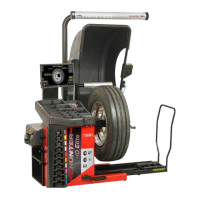4. SmartWeight® Balancing
4.1. SmartWeight Balancing Technology
SmartWeight® Balancing Technology is not a procedure. Rather, it is a technology that measures the forces of couple
side-to-side shimmy and static up-and-down shake and computes the correction weight required to reduce these forces.
This reduces the amount of weight used, reduces time, reduces check spins, “chasing weights”, and saves shop time and
money.
SmartWeight® Balancing Technology can reduce the number of steps in the balancing process. Not only does
SmartWeight® Balancing Technology give the customer a better riding vehicle, it also helps the environment by using
less corrective weight.
Static and non-rounding modes are eliminated to simplify operation. Always enter at least two weight positions during
wheel measurement in SmartWeight® balancing mode. All other functions are identical to the traditional balancing method.
Static and Dynamic Imbalance Sensitivity
As a general rule of thumb, to achieve the best balance on an average sized tire and wheel assembly Residual static
imbalance should be less than 1/4 ounce (7 grams).
• Residual couple imbalance should be less than 3/4 ounce (21 grams).
• Residual couple imbalance is preferred over remaining static imbalance.
• It takes much more residual couple imbalance weight to cause a vibration than the same amount of static imbalance
correction weight.
• The larger the diameter used for weight placement, the smaller the amount of correction weight is required for static
correction.
• The wider the distance between the two weight placement locations, the smaller the amount of correction weight is
required for couple correction.
• If static balance is the only option, always verify that the remaining couple residual imbalance is within acceptable
tolerance. This can only be veried using SmartWeight® balancing.
NOTICE
SmartWeight® balancing performs this check automatically.
4.2. SmartWeight® Balancing Technology Dynamic Weight Planes
SmartWeight® requires the operator to enter at least two weight planes. This balancing method will automatically
determine if one or both weight planes require a weight to be added. This eliminates “blinded” static single plane balancing,
which alone may not be sucient to solve couple vibration issues. The HD Elite® balancer offers two primary ways to
balance tires:
HD Elite Wheel Balancer
Page 35 of 51

